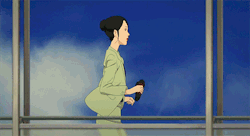|
The late Satoshi Kon was known for his interesting take on psychological mysteries. Whether it be the presentation of characters or the cinematographic choices made in each film, Kon could sell a character without revealing too much about their identity, and a perfect example of this would be the film’s protagonist herself, Paprika.
Paprika is presented as a happy go lucky dream detective who supposedly works for the Institute for Psychiatric Research. However, unlike most of the researchers who prefer a hands off approach to treating patients out of fear of reckless breakdowns to the overwhelming power of crawling into another individual’s dreams, Paprika is seen time and time again jumping in and out of her patient’s dreams with no seemingly negative side effects. All of this sounds impossible, and yet here is a character who seems to do just that. Does that mean she’s from the dream realm? Or perhaps she’s actually that in control of her conscious. LaBerge and Gackenbach both define a lucid dreamer as "people [who] are consciously aware that they are dreaming while they are dreaming." They also go on to state that lucid dreamers can "apparently be in full possession of their waking faculties while continuing to dream vividly." (1). As such, there's no fault in interpreting Paprika as the personification of such lucid dreaming. However, what makes Paprika even more of a puzzle to solve is how bizarrely impossible it is to get in contact with her. She only ever seems to appear in front of clients and also through the rather obscure internet website called radioclub.jp. So how would anyone ever get in contact with Paprika in the first place?
Jack Zipes explained in his opening paragraph of Why Fantasy Matters Too Much that "it is through fantasy that we have always sought to make sense of the world, not through reason."(2) One quote cannot better summarize the complicated relationship between Paprika and Doctor Atsuko Chiba, the two leading protagonists of the Paprika film. When Dr.Shima asks Dr.Chiba to convince Paprika to visit a patient, viewers must tie together that Paprika and Chiba have a certain connection to one another. While it is heavily hinted at through transition shots and dialogue between characters that Chiba and Paprika are two sides of the same coin, it’s their desire to seem like separate entities that creates a rather constructive view on the characters as a whole.
Satoshi Kon presents Paprika and Chiba as polar opposites through many different aspects, one of which being how they act in their ’respective’ domains. Take how Kon carries out the opening credits, shot by shot the audience is introduced to the fun loving and carefree Paprika as she skips merrily through the busy city night. As Paprika starts hitching rides on shirts and stopping time with a single snap, the audience can already infer that Paprika is an enigma in this realm. Then as sun rises the audience watches as Paprika transports almost magically into a car she passes. In comes three shots (a full shot, medium full shot, and medium shot) that show the Paprika’s transformation from the dream detective into the psychiatrist Atsuko Chiba. The transition is done in three shots not just to fit snuggly into the music sequence, but to also signify Paprika and Chiba’s connection.
Paprika is a part of Chiba and Chiba is a part of Paprika, but Chiba is very vocal about keeping the two identities separate. Chiba constantly refers to Paprika as an independent identity, reinforcing it through dialogue whenever it gets brought up. As the story progresses Chiba’s recent inability to dream gets brought up for a moment, only to get overshadowed by the chaos the T1-Mini created. It’s through this subtle moment the viewer becomes aware of why Chiba separates Paprika from herself, she has no power over her as Paprika dominates Chiba’s dream-like state. It should be noted this goes for Paprika as well, who can only appear to warn Chiba through visual moments that make her appear almost ghostly in comparison. But it’s for reasons like this that Kon’s mastery over duality presentation becomes astonishing to watch. When the transformation scene is repeated again, now in the opposite way of Chiba becoming Paprika the same three shot sequences is presented only reversed. It’s the tiny decisions like this that solidify that the two are equal in their own merits, no matter how much they want to interpret the other as a part of themself. Yet Kon doesn’t really go into much detail to fully merge the two characters together, nor does the audience even figure out where and when Paprika came to Chiba. But those fragments help to make the film all the more interesting to interpret for viewers and thankfully one thing will always be clear in the end,

"There’s always an opposite... and to spice it all up you add... Paprika!" (Paprika)
Illusion of Paprika
Home
|

